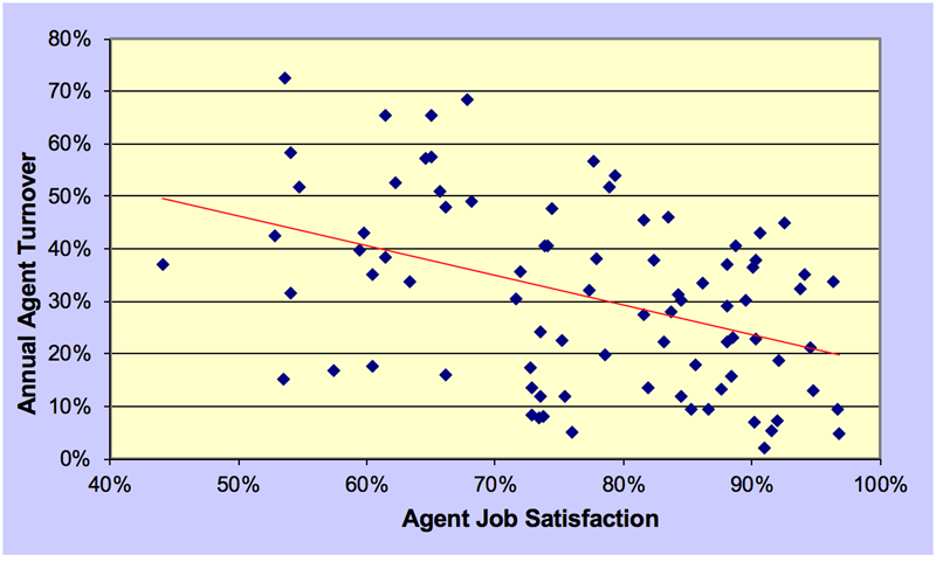
Solve Age-Old Problems and Make your Customer Service Agents Happier with a Virtual Contact Center
Virtual contact centers are changing the future of customer service. Since the beginning of 2021, the number of remote job postings across all industries increased dramatically. Between January and May of 2021, companies listed nearly 1.2 million remote roles. That’s around 400,000 more than in 2019, and almost triple the number of postings in 2020.
In the past, contact centers had a tendency to get stuck, caught in a time capsule with outdated technology, rules and KPIs that cling to the exact stereotype they’re trying to shake: that they’re a bad place to work.
We’ve seen the typical call center in TV shows and movies. The room is dimly lit, tightly packed, and windowless. The air feels tense and stagnant. It’s hard to hear above the clatter of keyboards and phones ringing off the hook. Agents juggle phone calls, quickly type out emails and talk down angry callers. This scene makes for good drama, but today contact centers look different.
The Future Trends of Remote Work and Virtual Contact Centers
Moving forward, more than 70% of companies will continue to have agents work from home at least part-time. Contact centers are no longer confined to windowless rooms with cubicles. They’re no longer bound by geographic restrictions. With the rise in virtual and cloud contact centers, we’re seeing more companies manage agents who work in separate buildings, cities, states, or even countries.
>> Read Now: How to Maintain a Fully Remote Virtual Contact Center Team
More than ever before, virtual contact centers are worth the investment. Not only are they saving costs for your company by reducing infrastructure costs for office space, but they offer unmatched flexibility for your agents. Giving your team more autonomy and flexibility leads to a happier team, and then happier customers to follow.
Why it’s Worth Your Time to Focus on Your Agents
Your agents spend hours a day dealing with generally grouchy, sometimes abusive customers. Maybe you’ve unconsciously added to that pressure with unattainable KPIs and slow technology. It’s not a shock that turnover rates in contact centers hover between 30-45%.
Agent job satisfaction is central to nearly every other metric in your call center. It’s positively correlated with customer satisfaction and negatively associated with absenteeism and turnover. Absenteeism and turnover go down as agent job satisfaction goes up.

Since improvements in agent job satisfaction can reduce agent turnover and absenteeism, it can also reduce the costs associated with turnover and absenteeism.
In North America, the direct cost of replacing a contact center agent, including the cost of screening, recruiting, interviewing, and training an agent is more than $12,000. Then, add on the loss of valuable knowledge and expertise that occurs every time an agent leaves your contact center. Plus, the productivity costs of disengaged agents looking for other jobs. Summed up, losing even one agent costs you a ton.
So, how do you drive agent satisfaction to prevent the negative side effects of unhappy employees?
As your leadership team debates the future of remote and flexible work, build a case for better technology that supports flexible work conditions to set your virtual contact center on a path to higher productivity and satisfaction.
>> Read Next: 3 Strategies You Need to Manage Thriving Virtual Contact Center Teams (+ Resources)
The Undeniable Benefits of Flexible Work
1. Increased Employee Productivity
Believe it or not, it’s hard to find evidence that flexible working conditions are less productive than physical offices. It may be hard as a manager to relinquish the control and oversight you have in a typical office environment. But, when you take your contact center virtual, you enable your agents to operate in an environment that suits their personal working styles.
Studies have shown that flexible work arrangements encourage greater productivity. And, recent surveys out of McKinsey and Co. show it’s clear employees want flexibility. As illustrated in the graph below, more than half of employees interviewed said they want organizations to adopt more flexible, hybrid working models. This model allows employees to sometimes work on-site and sometimes work remotely. A hybrid model can help organizations find better talent, lower costs, and strengthen organizational performance.
>> Download Now: 7 Projects for Your Contact Center Guaranteed to Reduce Inefficiencies and Bring More ROI to your Contact Center
Our clients put this theory to the test with their own agents, too. And, many found an increase in productivity and customer outcomes once sending their teams home in 2020. In fact, our friends over at Blackhawk Network saw a 4% reduction in handle times in a few short weeks. And since then, they’ve reduced handle times even further, seeing an 8% year-over-year decrease in AHT while operating under a hybrid model.
Hear what Pedro Reyes, their Director of Customer Service Operations had to say about it:
2. Greater Employee Well-Being
Give agents the option to work where they feel comfortable and balance their own priorities to see an increase in overall wellness. One primary benefit of flexible work is no commute! This has a direct impact on employee wellness (and on their bank accounts). It’s no secret that the time it takes to travel to a job is a huge opportunity cost.
Pre-pandemic, Americans alone spent almost two trillion minutes a year, collectively, traveling to and from work. Considering the U.S. only makes up 4% of the global population, it’s clear that commuting sucks the life out of the world’s economy.
And that’s just considering the time. The secondary effects, like stress, pollution, and infrastructure costs, are mind-blowing. Working from home instantly eliminates the vast majority of those problems for tons of workers. Without a commute, employees have more time to spend with family and to care for themselves.
>> Read Next: The Future of a Virtual Contact Center: What You Need to Know to Prepare for the Next Generation of Customer Care
Without the distractions in an office, your agents have the space to work through more challenging mental tasks. They have more time for exercise and will be more likely to eat home-prepared meals, benefiting their overall health. And, they have more time and flexibility to engage in hobbies and educational or charitable pursuits.
Flexible work presents more opportunity and time to care for your overall well-being so your agents can be their best selves when they get online for work.
3. Access to the Best Talent Available
Moving to a sustainable virtual contact center opens the door for a significantly larger pool of talent. Think first of the potential local talent that’s held back from working in a traditional office setting. For parents of young children, the elderly, and the disabled, it’s often a lot harder to leave the house for work, travel long distances, and deal with the stress of office work.
Being free to work from the quiet comfort of their own homes helps people preserve their independence. You can tap into a pool of talent that otherwise wasn’t available to you. Then, consider if you open up your flexible or virtual work outside your geographic location.
When hiring at-home call center agents, your labor pool widens beyond the geographic constraints of an office, so you can find top talent with unique skill sets anywhere. Discover new talent with a wider range in education, experience, and unique cultural skills.
This liberates the recruiting process and lets you get more selective when hiring employees. With a strong team of employees, you can get more done and improve your brand. Not to mention, your entire team benefits from having employees who are driven and engaged in work for the long haul.
Investing in flexible working environments and the tools that support them shows your employees you care about their longevity and well-being. The intentional focus on the needs of your agents is what starts to mend the gaps in the agent experience. And in turn, has a positive effect on your customer experience. When your leadership team debates the next steps for your workforce, consider accommodating the needs of your agents with a virtual (or hybrid) contact center and reap the benefits.
We originally published this post on October 2, 2017, and we updated it for new insight on October, 20, 2021.

